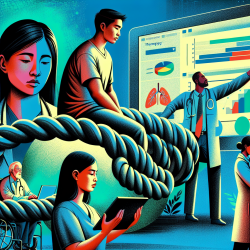As practitioners dedicated to creating great outcomes for children, it's essential to stay informed about the latest research and its implications for our practice. A recent study published in the European Journal of Health Economics, titled "Significant healthcare burden and life cost of spinal muscular atrophy: real-world data," provides valuable insights into the mortality rates, healthcare costs, and cumulative life costs associated with spinal muscular atrophy (SMA). This blog will explore the key findings of this study and discuss how practitioners can use this information to improve their skills and advocate for better outcomes for children with SMA.
Understanding the Healthcare Burden of SMA
SMA is a hereditary neuromuscular disease characterized by the degeneration of motor neurons, leading to progressive muscle weakness and significant disability. The study aimed to quantify the mortality rate, direct healthcare costs, and cumulative life costs for pediatric patients with SMA types 1, 2, and 3 born in Hong Kong.
Key Findings
- Mortality Rates: The overall incidence rate of death was 5.422/100 person-years, with the highest mortality observed in SMA type 1 (67.7%) and SMA type 2 (11%). The median age of death was 0.8 years for SMA1 and 10.9 years for SMA2.
- Healthcare Costs: The mean cumulative direct medical costs per patient were $935,570 for overall SMA, $2,393,250 for SMA1, $413,165 for SMA2, and $40,735 for SMA3.
- Hospitalization: Hospitalization accounted for the largest component of direct medical costs, making up 95% of the total costs for SMA patients.
Implications for Practitioners
These findings highlight the significant healthcare burden and economic costs associated with SMA, particularly for SMA1 and SMA2. As practitioners, we can use this data to advocate for early diagnosis and treatment, which can significantly improve outcomes and reduce healthcare costs. Here are some actionable steps:
- Early Diagnosis: Encourage newborn screening for SMA to identify affected infants early and initiate treatment before symptoms worsen.
- Advocate for Treatment Access: Support policies that provide access to novel disease-modifying treatments, such as nusinersen, onasemnogene abeparvovec-xioi, and risdiplam.
- Multidisciplinary Care: Ensure that children with SMA receive comprehensive care from a multidisciplinary team, including neurology, respiratory, orthopedic, and allied health professionals.
- Family Support: Provide families with the necessary resources and support to manage the high costs and emotional burden associated with SMA.
Conclusion
The study confirms the high mortality rates and healthcare costs associated with SMA, emphasizing the need for early diagnosis and treatment. By staying informed and advocating for better care, practitioners can significantly improve outcomes for children with SMA and reduce the associated healthcare burden.
To read the original research paper, please follow this link: Significant healthcare burden and life cost of spinal muscular atrophy: real-world data.










